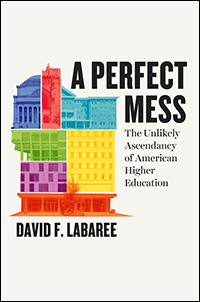(Higher Educations is) A Perfect Mess

David F. Larabee’s A Perfect Mess: The Unlikely Ascendancy of American Higher Education reminds us that the combination that colors higher education—neoliberal fiscalization, massive student debt, conflicts between administration and faculty, and debates over the future of our public schools—isn’t anything new. In fact, as Larabee argues, it’s been around as long as … free enterprise, or rather, as long as the free market, which never guaranteed a place for higher education in society. After the jump, read an excerpt from an interview with Larabee at Inside Higher Ed, which touches on his book’s argument: in this witch’s brew of the populist, the practical, and the elite, no single individual or institution can determine the future of the system. It takes a village, for better or worse.
***
Q: You seem to be suggesting not to worry too much about today’s problems, because higher education has always been a “perfect mess.” But are there issues that are notably worse today than in the past?
A: First, let me say a little about the advantages of the system’s messiness. In the next section, I’ll respond about the problem facing the system today. The relative autonomy and decentralization of American higher education allows individual colleges and universities to find their own ways of meeting needs, finding supporters and making themselves useful. They can choose to specialize, focusing on particular parts of the market — by level of degree, primary consumer base, religious orientation or vocational function. Or, like the big public and private universities, they can choose to provide something for everyone. This makes for individual institutions that don’t have a clean organization chart, looking instead like what some researchers have called “organized anarchies.”
The typical university is in constant tension between autonomous academic departments, which control curriculum and faculty hiring and promotion, and a strong president, who controls funding and is responsible only to the lay board of directors who own the place. Also thrown into the mix are a jumble of independent institutes, research centers and academic programs that have emerged in response to a variety of funding opportunities and faculty initiatives. The resulting institution is a hustler’s paradise, driven by a wide array of entrepreneurial actors: faculty trying to pursue intellectual interests and forge a career; administrators trying to protect and enrich the larger enterprise; and donors and students who want to draw on the university’s rich resources and capitalize on association with its stellar brand. These actors are feverishly pursuing their own interests within the framework of the university, which lures them with incentives, draws strength from their complex interactions and then passes these benefits on to society.
Q: What do you see as the major challenges facing academic leaders today?
A: The biggest problem facing the American system of higher education today is how to deal with its own success. In the 19th century, very few people attended college, so the system was not much in the public spotlight. Burgeoning enrollments in the 20th century put the system center stage, especially when it became the expectation that most people should graduate from some sort of college. As higher education moved from being an option to becoming a necessity, it increasingly found itself under the kind of intense scrutiny that has long been directed at American schools.
Accountability pressure in the last three decades has reshaped elementary and secondary schooling, and now the accountability police are headed to the college campus. As with earlier iterations, this reform effort demands that colleges demonstrate the value that students and the public are getting for their investment in higher education. This is particularly the case because higher education is so much more expensive per student than schooling at lower levels. So how much of this cost should the public pay from tax revenues and how much debt should individual students take on?
The danger posed by this accountability pressure is that colleges, like the K-12 schools before them, will come under pressure to narrow their mission to a small number of easily measurable outcomes. Most often the purpose boils down to the efficient delivery of instructional services to students, which will provide them with good jobs and provide society with an expanding economy. This ignores the wide array of social functions that the university serves. It’s a laboratory for working on pressing social problems; a playpen for intellectuals to pursue whatever questions seem interesting; a repository for the knowledge needed to address problems that haven’t yet emerged; a zone of creativity and exploration partially buffered from the realm of necessity; and, yes, a classroom for training future workers. The system’s organizational messiness is central to its social value.
***
To read more about A Perfect Mess, click here.
To read the interview in full, click here.